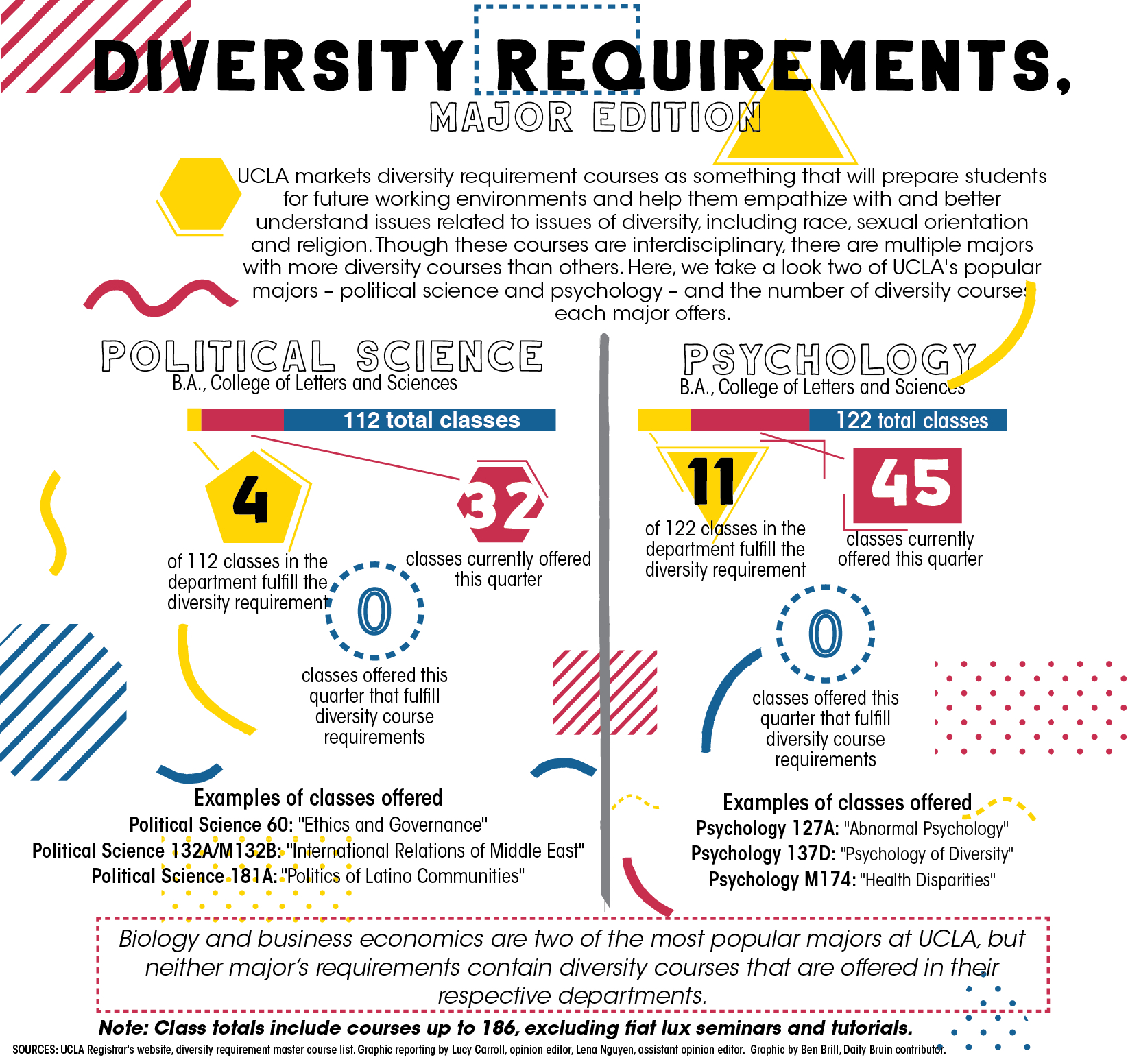Diversity courses are step in right direction but could be more major-inclusive

By Pamela Rayburn
Feb. 5, 2020 11:37 p.m.
This post was updated Feb. 13 at 4:15 p.m.
Pick up a UCLA brochure, and you’re bound to find words like “optimism,” “inclusion” and “diversity.”
But when it comes to the classroom, UCLA has a chance at making diversity mean something beyond a slogan.
In 2015, UCLA approved a diversity course requirement for most undergraduate colleges. These classes deal with topics of diversity, such as race, religion and gender, with the goal of making students more well-versed in understanding the different identities of their fellow Bruins.
Students at UCLA come from all walks of life. But for a requirement meant to reflect that, diversity courses are overwhelmingly seen as another nonmajor box to check off the list.
And checking boxes doesn’t do justice to the importance of diversity.
The modern workplace is diverse, and if any UCLA graduate wants to thrive, they need these courses, regardless of their career aspirations.
Currently, diversity courses are clustered in certain subject areas, forcing students outside of their fields unequally and creating an unfair burden on students from certain majors. Especially in STEM fields, in which such diversity courses are often lacking, better integrating diversity courses into major requirements could be influential in a Bruin’s postgraduate experiences.
With hundreds of courses meeting the diversity criterion, it seems there would be something for students in every field of study. Instead, most of the courses that fulfill the requirement are in the liberal arts, with limited options for overlap in the sciences.
More specifically, a large portion of the diversity courses are in ethnic studies departments, such as African American studies, Chicana and Chicano studies and Asian American studies.
In spring quarter, Lily Anne Welty Tamai, a lecturer in the Asian American studies department, will be teaching Asian American Studies 20W: “Contemporary Asian American Communities,” a diversity course focused on immigration and sociocultural and interethnic issues.
“(The diversity requirement) is the UC’s attempt to increase the liberal arts education for students here so that they’re taking courses that they probably would not have selected on their own,” Welty Tamai said.
Surely, getting students outside of their comfort zone is great. But for students with demanding major requirements, the lacking integration of diversity courses can be an issue.
And that can leave students unappreciative of courses that could genuinely benefit them.
Information about diversity and cultural empathy is missing from an early stage in the education system. Welty Tamai said Asian American students might not even be aware of their own histories, as the K-12 education system in the U.S. lacks a diversity curriculum.
That’s precisely why UCLA needs to prioritize better integration of these course requirements. Given that students’ prior education often leaves them with one-sided views of history and culture, these classes offer opportunities to broaden their understanding.
“You can’t expect everyone in your field to be of the same race,” said Pavan Jonnalagadda, a third-year aerospace engineering student. “If you want to establish better rapport with (people), you may want to relate to them, so having a diversity course may help you do that.”
With diversity topics marginalized in traditional education curricula, these courses can better inform students of what they may face in the real world.
This includes putting names to experiences such as microaggressions, said Welty Tamai.
According to the American Psychological Association, microaggressions have been defined by researchers as subtle insults that are not intentionally harmful or racist, but affect cultural minorities with higher frequency. In workplaces, microaggressions occur often – even if inadvertently. And while diversity courses can’t fix systemic racism, they can bring awareness to biases and behaviors people didn’t realize they had.
Neuroscience and physics students are affected by these behaviors as much as students in the next major; yet UCLA’s current approach means an ethnomusicology or labor studies class may seem like just another requisite for these students.
And the STEM disciplines don’t exist in a vacuum.
Students who complete those degrees will be entering fields that desperately need well-informed workers. For example, a future doctor must know how cultural differences or religious affiliations affect patient treatment.
However, diversity can easily be integrated into the sciences – for example, Welty Tamai said her diversity course propels some STEM students to minor in Asian American studies, as they consider the impact their degrees have on their communities.
UCLA can do more to offer diversity courses that are relevant to individual majors. The future of various fields – whether it be STEM or business economics – relies on a social and cultural understanding of others, and new diversity courses should be established with this logic in mind.
Monica Smith, a professor in the anthropology department who teaches religion and urbanism, said that diversity classes can modernize topics that may seem distant to students in Los Angeles.
“We want students to be prepared for the world that they’ll be working in after they have their degrees,” Smith said. “They will be working with people who come from different perspectives and from different parts of the world.”
But not everyone thinks the diversity requirement is needed for students of all majors. With an added emphasis on STEM, the importance placed on the soft skill set integral to humanities and liberal arts fields has arguably decreased in importance. Certainly, that emphasis exists, but a STEM-focused curriculum can rely too much on technical knowledge and leave out the importance of human interaction.
It’s not perfect, but the diversity requirement is a way to prepare students for the interpersonal skills requirement on future job applications.
So the next time you pick up a UCLA brochure and read the flowery words, know that UCLA is making efforts toward diversity in education, but they still have a few steps to go.

